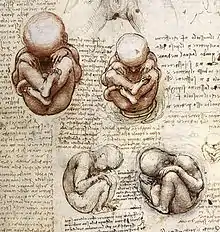Fetal position
Fetal position (British English: also foetal) is the positioning of the body of a prenatal fetus as it develops. In this position, the back is curved, the head is bowed, and the limbs are bent and drawn up to the torso.

This position is used in the medical profession to minimize injury to the neck and chest.
Sometimes, when a person has suffered extreme physical or psychological trauma (including massive stress), they will assume the fetal position or a similar position in which the back is curved forward, the legs are brought up as tightly against the abdomen as possible, the head is bowed as close to the abdomen as possible, and the arms are wrapped around the head to prevent further trauma.
The fetal position has been observed in drug addicts, who enter the position when experiencing withdrawal. Sufferers of anxiety are also known to assume the fetal position during panic attacks.
Many people assume this position when sleeping, especially when the body becomes cold.
Assuming this position and playing dead is often recommended as a strategy to end a bear attack.[1]
Many baby mammals, especially rodents, remain in the fetal position well after being born.
References
- "Bear Attacks Their Causes and Avoidance" by Stephen Herrero, p. 24 ISBN 0-941130-82-7